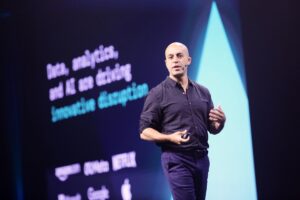[ad_1]

(whiteMocca/Shutterstock)
One of many complaints heard about Databricks through the years–that it’s advanced to arrange and generally tough to make use of–will should be revisited now that the corporate is making its whole knowledge platform serverless.
Databricks at the moment provides a serverless choice for some capabilities, which means that clients aren’t liable for spinning up clusters or spinning them again down after they’re accomplished. However a lot of the platform depends on underlying compute clusters that price the shoppers cash whether or not or not they’re utilizing them.
That’s altering. Throughout his keynote on the firm’s Information + AI Summit on Wednesday, Databricks CEO and co-founder Ali Ghodsi introduced that, beginning July 1, your complete Databricks platform can be accessible as serverless.
“With serverless, you’re simply paying for what you’re utilizing,” Ghodsi mentioned. “The truth is, there is no such thing as a cluster to arrange for it to be idle or not idle. So we’ll handle all of that for you below the hood.”
Databricks runs on all the most important clouds–AWS, Azure, and Google Cloud–and depends on these cloud platforms for storage, compute, and networking. Storage is fairly simple within the cloud, as Databricks expects buyer knowledge to be saved of their cloud object storage accounts, whether or not its S3 (Easy Storage Service) on AWS, ALCS (Azure Lake Cloud Storage) on Azure, or GCS (Google Cloud Storage) on GCP.

Databricks CEO Ali Ghodsi delivers a keynote at Information + AI Summit 2024 (Picture courtesy Databricks)
However establishing the compute is extra sophisticated. Prospects could provision the compute for his or her ETL, streaming knowledge, SQL analytics, or ML/AI coaching jobs by way of Databricks, however they’re billed for the compute by way of their account with the cloud platform. Going serverless adjustments that compute equation.
“All these knobs that we had earlier than are gone,” Ghodsi mentioned. “Cluster tuning–you might have individuals establishing clusters. What kind of machines ought to they use? Spot cases?…Ought to we auto scale? None of that’s accessible anymore. It’s simply gone. There’s no such web page. You possibly can’t try this.”
Going serverless additionally helps clients by decreasing the necessity to perceive previous utilization and use that for capability planning functions, Ghodsi mentioned. (Nonetheless, there’s a caveat round networking, as Databricks at the moment doesn’t cost for incurred community prices for serverless workloads, however reserves the best to take action sooner or later, based on its serverless documentation.)
There are additionally advantages to going serverless from the attitude of safety and knowledge layouts, Ghodsi mentioned.
“We’re additionally capable of do safety a distinct method as a result of once more, we personal all of the machines and are capable of actually lock it down otherwise. That’s not attainable when it’s not serverless,” he mentioned. “The information format–how are you going to set out precisely your knowledge units? How are you going to optimize your knowledge units? That’s additionally gone. We’re simply optimizing behind the scenes. As a result of it’s serverless, we simply run within the background optimization in your knowledge set to make it actually quick and optimum utilizing machine studying. In order that’s additionally actually superior.”
Databricks will profit from the shift away from versioning software program releases; there can be no extra variations, as Databricks will mechanically replace the software program, giving all customers entry to the identical fixes and options on the identical time.
Databricks engineers spent the previous three years engaged on the serverless model of its platform, Ghodsi mentioned. It took that lengthy as a result of the engineers primarily needed to rewrite all of its choices, which is one thing that was a matter of debate throughout the firm.
“Two to 3 years in the past, my cofounder Matei [Zaharia, Databricks’ CTO] and I informed the corporate ‘We’ve bought to construct a lift-and-shift, easy model of serverless.’ And really our engineers pushed again, and mentioned ‘Hey, you guys are incorrect. We must always redesign it from scratch for the serverless period.’ And we informed them ‘Nope. We determine within the firm.’ And it turned out we had been incorrect. The tech leads had been proper. They usually’ve been working actually exhausting for 2 years to principally redesign lots of the merchandise–the notebooks, the roles, the whole lot–as if we now have began a brand new firm.”
The shift to serverless received’t occur in a single day on June 30 (regardless that it’s a Sunday, which is right). It would take time to transition all 12,000 Databricks clients to the serverless variations of the merchandise they’re utilizing, whether or not it’s Spark clusters or Structured Streaming or notebooks or MosaicAI.
Databricks is making investments all over the world to make sure serverless variations of its merchandise can be found in each cloud knowledge middle it runs. The corporate can be strongly encouraging clients to make the transfer to serverless before later.
“Please begin utilizing serverless,” Ghodsi mentioned. “Sooner or later, new merchandise that we roll out…they’ll in all probability solely be accessible in serverless. So in case your group is just not on serverless, please get on it.”
For more information on Databricks’ serverless, see the discharge notes.
Associated Objects:
Databricks to Open Supply Unity Catalog
Databricks Unveils LakeFlow: A Unified and Clever Instrument for Information Engineering
Databricks Sees Compound Methods as Remedy to AI Illnesses
[ad_2]

Leave a Reply